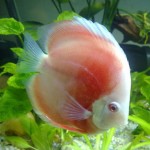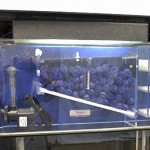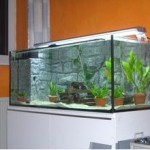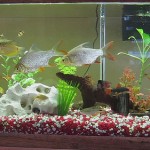
Below is a list of the most common fish diseases in freshwater aquariums.
Columnaris
Grayish white marks or patches on the body of the fish or around its mouth are the first obvious signs of Columnaris. These patches appear like threads, especially in the vicinity of the mouth. Hence, this is often confused with another disease called “Mouth Fungus“. The fins of the fish may show signs of deterioration, the gills get affected and slowly sores start appearing on the body. During a later stage the fish can hold its fins very close to the body and not spreading them. Columnaris disease is caused by bacteria, and is mostly a direct result of poor water quality. Sometimes, the shock of being introduced to the new aquarium leads to Columnaris disease in newly imported fish. Anti-bacterial medications will be enough if the disease is discovered and treated at its early stages. The disease will however invade the internal organs during the later stages and antibiotics are then required to cure it.
Gill Disease
Gill disease make the fish appear to be swimming in a great hurry, but it does not move at all. The fins flap very fast, and the fish gasp for breath at the surface, or lie listless at the bottom. The gills become swollen and discolored. Bacteria, fungi and parasites in water can cause gill disease. The first step in the treatment is therefore an immediate improvement in water quality. Frequent water changes, conditioning and dechlorinating the water to ensure its quality are steps to take to threat and prevent gill disease. The chlorine in water often irritates the gills of the fish. Adding an anti-bacterial solution to the water may be needed to cure the fish.
Ick
Ick is a disease that causes your fish to get small, grain-like spots on their body. Ick is also known as White Spot Disease or Ich. The fish may try to rub itself against the décor or the hard surfaces in the aquarium, giving an impression of scratching an itch. In freshwater, this disease is caused by protozoa named Ichthyophthirius Multifilis and is very contagious. The parasite spends a part of its life within the skin of the fish, where they form the white spots. These are the cysts. Once the cysts mature they fall down to the substrate and give rise to thousands of new free-swimming parasites that are free to prey upon other fish. An outbreak of Ick is very difficult to control if not noticed in the earlier stages. Since the parasite is released into the aquarium, the entire aquarium has to be treated. One of the effective ways to treat it is by adding salt to the water. The salt should be added gradually, slowly building upto5-8 tsp per gallon / 4L. Different fish have different tolerance level for salt. In the case of more sensitive fish, it is better to keep the level at 5 tsp. per gallon / 4L. Using medications based on Malachite green and formalin is also a way to control this parasite, but Malachite Green may be harmful to scaleless fish.
Killing the parasite can be done only when the cysts have fallen down and the parasites are released into the water. Increasing the water temperature speeds up the life cycle of the protozoa. Keep in mind that increased water temperature may deplete the oxygen in the aquarium.
Dropsy
The common physical characteristic of this disease is a hollow or swollen abdomen. The fish’s scales may stand out in these swollen areas. It is easy to mistake such fish for pregnant females. The fish appear listless and lose appetite. Viruses as well as bacteria can cause dropsy. Bad water or infected food is things that can lead to dropsy out brakes in your aquarium. Once the damage reaches the kidney, the condition becomes almost incurable. The disease must therefore be caught early if you should be able to save your fish. This disease is unfortunately very difficult to cure even if discovered early. Dropsy is however is not highly infectious. Dead fish should still be immediately removed from the aquarium; otherwise healthy fish may come and eat the dead one. Commercially available remedies do best.
Fin-rot
As the name suggests, fin rot causes the fins to turn opaque and they may even become blood-streaked. The erosion of the fin may continue till it reaches the base of the fin. At this point, the fish dies. The bacteria that cause this generally do not affect healthy fish. When fish are stressed, or when the fins have already been damaged due to excessive fin nipping, then the disease takes root. Commercially available anti-bacterial medicines have to be used to treat the fish.
Fungal Infections
The spores of fungus are always present within the aquarium, and can become infectious when the fish already have damaged gills or skin. Fungal infections are typically secondary infections. White, cottony growth on the body of the fish is the main physical symptom. Anti-fungal medicines are usually the best option to fight the infection. Most of the anti-fungal medications available on the market also fight bacteria, thus providing double protection.
Hole in the Head
As the name suggests, the fish develop small pits mainly in the region of the head. The holes are usually white in color and have a yellowish mucous trailing from them. The fish become listless, lose color and stop feeding. Hole in the head disease is cause by protozoa and is usually a secondary infection. Low levels of the protozoa that causes hole in the head disease live within the fish, and poor water quality and/or poor diet leads to the infection. The fish should be isolated in a quarantine aquarium and then treated. Direct injections or medicated food are some ways to treat the fish.
Pop-Eye
The name suggests the physical symptom. The fish’s eye starts to enlarge and looks almost as if it is ready to pop out of the body. The cause could be bacteria. Too much dissolved oxygen in the water may also lead to this condition. There is no universal cure. Isolate the fish, and treat it with general anti-bacterial medicine.
Cloudy Eye
The eye becomes cloudy almost to the point of whiteness and the fish lose vision. The causes behind this disease can vary. An increase in parasites in the aquarium is the most common cause but severe stress, old age, or malnutrition can all lead to this condition. Treating this condition requires an investigation of water quality. Once the water quality is high enough, the fish will usually recover by them selves within 1-2 weeks. Thus, it is advisable to wait for 1-2 weeks before administering antibiotics.
Swim Bladder Disease
This mostly affects fish that have a globoid body shape. A loss of buoyancy is one of the first indications. The fish stays at the bottom of the aquarium, unable to rise, or float at the surface only. This is due to the fact that the swim bladder is what helps the fish to remain buoyant. Any damage to this membrane causes this disease. There is considerable debate about the cause of this disease and the best way to cure it.
Fish Lice
Small, white lice are apparent on the body of the fish and the fish rub themselves against the hard surfaces in the aquarium. Red spots or sores develop. The best way to treat fish lice is to remove the lice using a set of tweezers. Siphon the substrate daily to get rid of eggs. If the infestation is heavy, medication will be needed.
Nematode Worms
The anus of the fish may protrude a little, and a thin threadlike worm will drift out of the anus. The fish becomes listless and bloated. It refuses to feed. Anti-worm medication developed for aquariums are usually affective against nematode worms. Nematodes are commonly present even in healthy fish, but can turn into a problem when the fish becomes weakened due to some other reason.
Water Quality Induced Diseases
The most common among these are caused by an imbalance in the water chemistry. Ammonia poisoning is caused when too much organic waste is present in the water. If the pH of the water goes above 7.0 the ammonia turns deadly and toxic for the fish. The first indication is that the gills turn a different color and the fish gasp for breath and become listless. The source of the waste has to be removed and the pH of the water should be reduced to treat this condition.
Carbon Dioxide poisoning can be caused by too much of Carbon Dioxide. Good aeration and frequent water changes are the best way to treat and prevent this problem.
Nitrite or Nitrate poisoning shows itself by making the fish appear too bright. The fish remain panting for breath and hang just below the surface.
Poisoning may also occur by using untreated tap water.















